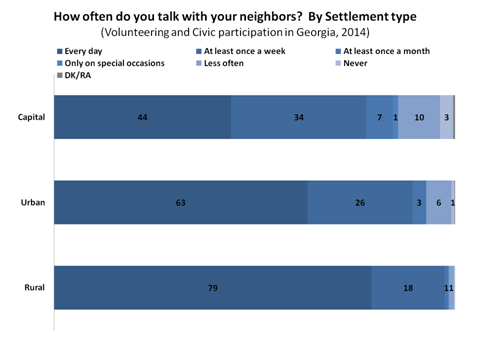Living in either a rural or urban area has both costs and benefits –there are a number of contrasts in lifestyle, access to goods or services, and information. This blog post looks at how urban and rural populations in Georgia relate with their neighbors, using data from the 2014 Volunteering and civic participation in Georgia survey, funded by East-West Management Institute (EWMI) / G-PAC.
One of the distinctions between different settlement types is the duration people have been living in a given neighborhood. Unsurprisingly, the data shows that residents of the capital and other urban settlements are more likely to have changed their neighborhood recently in comparison with the rural population.Those who have lived in their current neighborhood for less than six years are much more common in the capital (27%) compared with other urban (15%) and rural (8%) settlements.
Living in an urban area changes traditional forms of social behavior. In particular, the data shows that the majority of the population who live outside the capital report knowing all the families in their neighborhood, compared with only 34% of those living in the capital. Even controlling for how long residents have lived in a particular neighborhood, the population of the capital is still much less likely than the rest of the population to know all of their neighbors.
Note: The chart presents data for two extreme groups only – those who have lived in a given neighborhood for up to 5 years, and those who have lived there for more than 45 years. Information about those who have lived in a given neighborhood for between 6 and 45 years is not presented.
Those living in Tbilisi communicate with their neighbors less than those living outside the capital. While 79% of residents of rural settlements report talking with their neighbors daily, 63% of residents living in urban settlements outside Tbilisi and only 44% of Tbilisi residents do the same.
Lower engagement with neighbors in the capital could be related to the fact that nearly one-third of capital dwellers moved to their neighborhood within the last five years. This, however, is not the only possible explanation. What do you think?
To explore issues related to neighbors and social interaction further, take a look at the data using CRRC’s Online Data Analysis tool.



